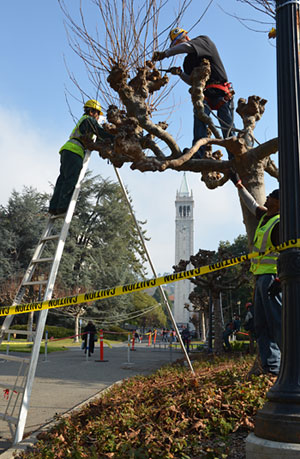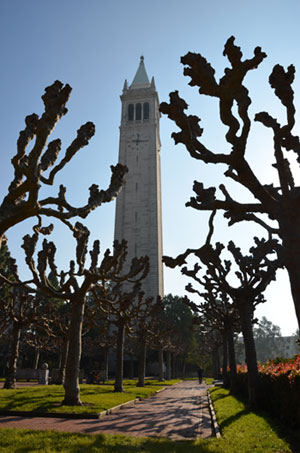‘Pollarding’ trains trees in surrealist school
Grounds crews use pruning technique traced back to medieval Europe to give Berkeley's signature trees their distinctive look.
December 14, 2011

Workers remove new growth from a London plane tree on Campanile Way. (Roibín Ó hÉochaidh photo)
Grisly, grotesque or Gothic-chic, the several hundred London plane trees that dot the campus have become a signature element of the visual landscape at UC Berkeley.
All gnarled knuckles and barren boughs, the iconic arbors are, however, not the product of some rampant contagion or genetic mutation.
The Tim Burtonesque aesthetic is the truncated trees’ natural response to “pollarding” — an age-old pruning technique that removes new–growth shoots before they mature into thicker branches to maintain the height and health of the tree.
“It’s strange, they look dreary and dead, but they always lift my spirits,” says Theron Klos, operations manager for central-campus gardeners.
“If you’ve ever been up at the Campanile on a crisp, foggy December morning, and you see those gnarled bulbs… it looks really cool,” he adds.
The optimal season to pollard plane trees is late fall through early winter, and campus grounds crews are out in force this month pruning almost half of the campus’s more than 240 London plane trees.
Work crews have already finished pruning the plane trees at the foot of Sather Tower, and are now working on those lining Campanile Way.
Weather permitting, the pollarding teams will move on to the trees around Evans Diamond and Kroeber Hall, and those lining the Wheeler Hall-Durant Hall corridor.
Work areas are being cordoned off to safeguard students, staff and visitors during the tree-trimming operation, which is scheduled to run through Dec. 23.

Pollarding gives Berkeley’s London plane trees their distinctive look. (Roibín Ó hÉochaidh photo)
Historians trace the modern practice of pollarding back to medieval Europe, where feudal lords — who owned the trees — permitted the peasantry to harvest foliage and new-growth branches for firewood, animal feed and building materials.
“You don’t see trees like this very often, so when you do, it really imprints on your brain,” Klos says. “For me, they look weird when we don’t pollard them.”
Today, pollarding remains a highly labor-intensive and time-consuming process, and Klos and his team have been working with Jim Horner, campus landscape architect, to develop a more efficient and effective plane-pollarding plan.
“This is just one of those things we’ve had to look at with the current budget situation and staffing issues,” Klos says. “But it’s really a question of finding the right mix because we’re trying to maintain the health of the trees.”
Next fall, grounds staff plan to prune more than 75 percent of the plane trees. After 2012, crews will pollard half the trees each year on a rotating basis, save for those surrounding the Campanile, which will continue to be pruned annually.